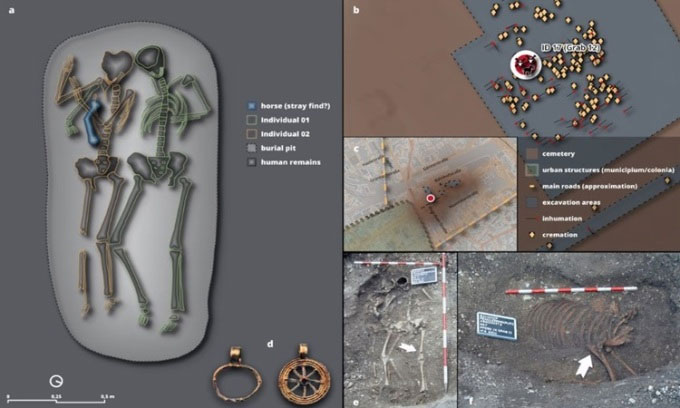Analysis results of a double grave in Austria revealed that the two sets of remains were not husband and wife, but a mother and child pair who lived during Roman times .
Centuries ago, two people were buried hand in hand on top of a horse in a tomb that is now located in Austria. The unique burial position makes archaeologists believe that the owner of the tomb is a couple from the Middle Ages. However, new analysis of the two sets of remains revealed that the mother and child pair died about 1,800 years ago during the Roman period. “What is the first mother and daughter burial in Roman Austria that has been proven through genetics,” said Sylvia Kirchengast, a professor of evolutionary anthropology at the University of Vienna.
 Position of two sets of remains in a double tomb in Austria. (Photo: Live Science).
Position of two sets of remains in a double tomb in Austria. (Photo: Live Science).
Archaeologists unearthed three skeletons (two adults and a horse) along with two gold pendants in the shape of a wheel and a crescent moon in 2004 from the cemetery in the ancient Roman city of Ovilava, Today the name is Wels in the state of Upper Austria . One individual’s right hand is placed around the other’s shoulder, indicating a close relationship between the two individuals. Initial analysis classified the Bavarian tomb as 6th to 7th century based on depth and west-east orientation.
In the new study, scientists re-evaluated the remains through carbon dating, ancient DNA analysis and visual inspection. They found that the two skeletons belonged to individuals who died at the ages of 20 – 25 and 40 – 60, living around the year 200 when the Roman Empire dominated the region. In particular, both skeletons are female, according to anatomical analysis. DNA test results confirmed that the deceased was female and had a first-degree biological relationship , meaning they were sisters or mother and daughter , according to research published in the May issue of the journal Archaeological Science: Reports. .
Due to DNA results, age difference and many other factors, the research team concluded that the two individuals were mother and daughter, with the daughter hugging her biological mother in the grave. ” The possibility that two people were 20 years older than each other was very low at that time. So we realized that they were definitely a mother and daughter pair,” Kirchengast shared.
The addition of the horse and gold pendant revealed that the women in the tomb had a high social status and were not part of the Roman aristocracy, according to team leader Dominik Hagmann, an archaeologist at the University of Vienna. He suspected the two individuals were from the Celtic civilization that existed under the Romans. Celtic people often buried horses with their owners. In addition, there are many other signs that show that the dead person was very familiar with horses. Both women can ride horses regularly.
Katy Knortz, a doctoral student in archeology and classical art at Princeton University, said that while the possibility that the two women were sisters could not be completely ruled out, the protective posture of the remains and the difference A large age difference makes the mother-child relationship more likely.





